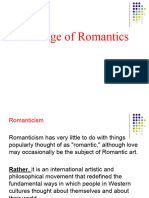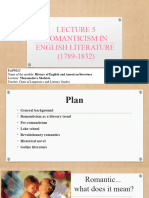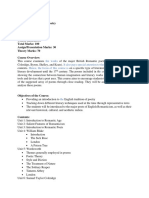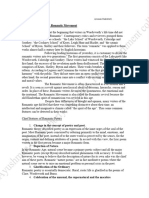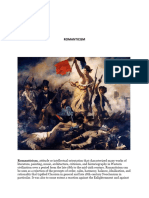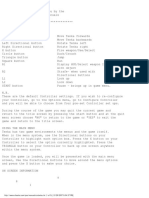NAME: Reva Hukkerikar
ROLL NO.: 1308
YEAR: IInd Year
ROMANTICISM
Romanticism may be understood as a rejection of the tenets of order, serenity, harmony,
balance, idealisation, and rationalism that characterised Classicism in general, and late
18th-century Neoclassicism in particular. It was also, to some part, a reaction to the
Enlightenment, as well as 18th-century rationalism and physical materialism in general.
Romanticism stressed the individual, the subjective, the irrational, the imaginative, the
personal, the spontaneous, the emotional, the visionary, and the transcendental.
Romanticism was characterised by the following attitudes: a deepened appreciation of
nature's beauties; a general exaltation of emotion over reason and of the senses over
intellect; a turning in on oneself and a heightened examination of human personality and its
moods and mental potentialities; a preoccupation with the genius, hero, and exceptional
figure in general, with a focus on his or her passions and inner struggles; a fresh perspective
on the artist as a profoundly unique creator, whose creative spirit is more vital than rigid
obedience to formal norms and established methods; a focus on imagination as a pathway
to transcendent experience and spiritual truth; an intense fascination with folk culture,
national and ethnic cultural roots.
Pre-Romanticism refers to a series of connected events that occurred from the mid-18th
century onward. Among these tendencies was a renewed interest in mediaeval romance,
which gave rise to the Romantic movement. The romance was a chivalric adventure story or
ballad whose emphasis on individual heroism, the exotic, and the mysterious stood in stark
contrast to the elegant formality and artificiality of dominant Classical forms of literature,
such as French Neoclassical tragedy or English heroic couplet in poetry. This new interest in
relatively crude but bluntly emotional literary representations of the past was to be a
recurring theme throughout Romanticism. The release of William Wordsworth's and Samuel
Taylor Coleridge's Lyrical Ballads in the 1790s signalled the beginning of Romanticism in
English literature. The "Preface" to the second edition of Lyrical Ballads by Wordsworth, in
which he characterised poetry as "the spontaneous outburst of great sentiments," became
the credo of the English Romantic movement in poetry. William Blake was the movement's
third major poet in England during its early stages. In Germany, the initial phase of the
Romantic movement was distinguished by advances in both content and literary form, as
well as a fascination with the mystical, subconscious, and supernatural. In his book The
Social Contract, Jean-Jacques Rousseau wrote in 1762, "Man is born free, and wherever he
is chained." Major social shifts occurred throughout the Romantic period, when unsatisfied
intellectuals and artists challenged the Establishment. The Romantic poets of England were
at the epicentre of this movement. They were motivated by a yearning for liberty and spoke
out against impoverished people's exploitation. There was a strong focus on the significance
of the person, and a belief that individuals should pursue their goals rather than enforced
traditions and regulations. The Romantics rejected the logic and order of the earlier
Enlightenment age, emphasising the value of expressing genuine emotional sentiments.
They felt a strong bond with their fellow males. The second phase of Romanticism, which
lasted from about 1805 to the 1830s, was marked by a resurgence of cultural nationalism
and a renewed focus on national origins, as evidenced by the collection and imitation of
native folklore, folk ballads and poetry, folk dance and music, and even previously ignored
�mediaeval and Renaissance works. Though inspired by other creative and intellectual
groups, the beliefs and events of the French Revolution established the major background
from which both Romanticism and the Counter-Enlightenment evolved. Upholding the goals
of the Revolution, Romanticism was a protest against the aristocratic social and political
conventions of the Age of Enlightenment, as well as a response to scientific rationality of
nature. Romanticism extolled the exploits of what it saw as heroic individualists and artists
whose pioneering examples would uplift society. It also legitimised the human imagination as
a critical authority, allowing for artistic independence from traditional ideals of form.Sir Walter
Scott, often regarded as the father of the historical novel, turned the revitalised historical
interest into creative literature. Around the same period, English Romantic poetry had
achieved its pinnacle with the works of John Keats, Lord Byron, and Percy Bysshe Shelley.
The Romantics did not always agree on what they said and did: far from it! Nonetheless,
essential concepts dominated their literature. They truly believed they were prophetic beings
with the ability to discern reality. The Romantics emphasised the healing power of the
imagination because they sincerely felt it could help people transcend their difficulties and
situations. Their creative abilities have the potential to illuminate and convert the world into a
cohesive vision, so as to spiritually regenerate mankind. Shelley increased the stature of
poets in A Defence of Poetry (1821), saying, "They measure the circumference and hear the
depths of human nature with a comprehensive and all-penetrating spirit..." He stated, "Poets
are the world's unacknowledged lawmakers." Wordsworth was worried about the elitism of
previous poets, whose sophisticated language and subject matter were neither easily
accessible or particularly relevant to common people. He insisted that poetry be democratic,
written in "the language truly spoken by mankind." As a result, he attempted to provide a
voice to people who were marginalised and mistreated by society: rural poor, discharged
soldiers, 'fallen' women, the crazy, and children. Wordsworth's 'Tintern Abbey' (1798)
combined periods of jubilation and hope with grief and sadness. Keats conceived in terms of
an antithesis between the imagination and the intellect. In a letter to his brothers amid
December 1817, he described what he meant by the phrase "Negative Capability": "that is
when a man is capable of existing in uncertainties, Mysteries, doubts, without any impatient
grasping for fact and reason" . Keats proposed that it is difficult for us to discover solutions to
the timeless questions we all have regarding human life. Instead, our emotions and
imaginations enable us to recognise Beauty, and it is Beauty that helps us get through life's
difficult times. Life is a delicate balance of joy and misery.
Blake's political views were extreme, with many of his poems addressing social issues and
expressing his dissatisfaction with the monarchy and the church. In his poem "London," he
highlights the plight of chimney sweeps, soldiers, and prostitutes.
The authors saw themselves as figures who could interpret reality. The Romantics
emphasised the healing potential of the creative imagination. Their imaginative abilities have
the potential to educate and transform the world into a comprehensible picture . Another
distinguishing element of Romantic literature was its turn away from the mimetic, or imitative,
tendencies of the Neoclassical age and toward a fresh emphasis on imagination. Coleridge
saw the imagination as the greatest poetic quality, a semi-divine creative energy that
elevated the poet to godlike status. Significant social upheavals occurred during the
Romantic period, when unsatisfied intellectuals and artists challenged the Establishment.
The Romantic writers in England were at the epicentre of this trend. They were motivated by
a desire for liberty and opposed the exploitation of the poor. There was a focus on the
significance of the person; a belief that individuals should pursue ideas rather than enforced
traditions and regulations.








